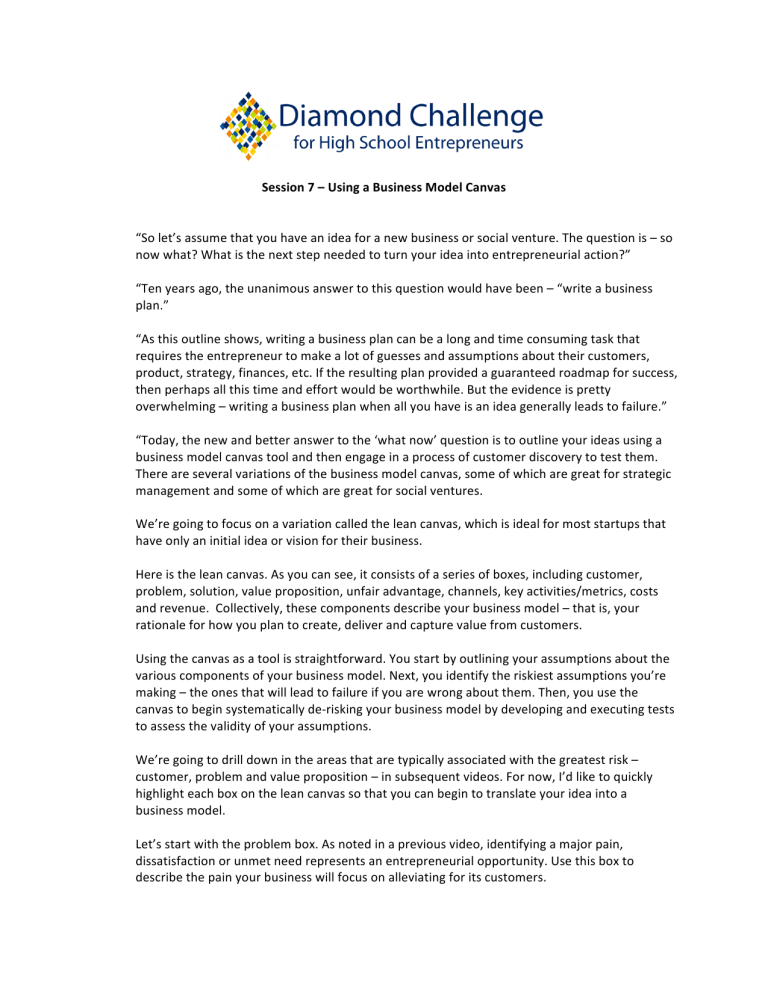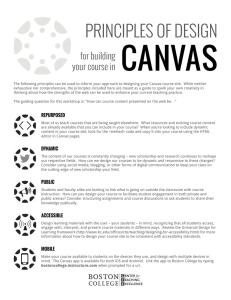Session 7 – Using a Business Model Canvas “So let`s assume that

Session 7 – Using a Business Model Canvas
“So let’s assume that you have an idea for a new business or social venture. The question is – so now what? What is the next step needed to turn your idea into entrepreneurial action?”
“Ten years ago, the unanimous answer to this question would have been – “write a business
plan.”
“As this outline shows, writing a business plan can be a long and time consuming task that requires the entrepreneur to make a lot of guesses and assumptions about their customers, product, strategy, finances, etc. If the resulting plan provided a guaranteed roadmap for success, then perhaps all this time and effort would be worthwhile. But the evidence is pretty
overwhelming – writing a business plan when all you have is an idea generally leads to failure.”
“Today, the new and better answer to the ‘what now’ question is to outline your ideas using a business model canvas tool and then engage in a process of customer discovery to test them.
There are several variations of the business model canvas, some of which are great for strategic management and some of which are great for social ventures.
We’re going to focus on a variation called the lean canvas, which is ideal for most startups that
have only an initial idea or vision for their business.
Here is the lean canvas. As you can see, it consists of a series of boxes, including customer, problem, solution, value proposition, unfair advantage, channels, key activities/metrics, costs
and revenue. Collectively, these components describe your business model – that is, your rationale for how you plan to create, deliver and capture value from customers.
Using the canvas as a tool is straightforward. You start by outlining your assumptions about the various components of your business model. Next, you identify the riskiest assumptions you’re making – the ones that will lead to failure if you are wrong about them. Then, you use the canvas to begin systematically de-‐risking your business model by developing and executing tests to assess the validity of your assumptions.
We’re going to drill down in the areas that are typically associated with the greatest risk – customer, problem and value proposition – in subsequent videos. For now, I’d like to quickly highlight each box on the lean canvas so that you can begin to translate your idea into a business model.
Let’s start with the problem box. As noted in a previous video, identifying a major pain, dissatisfaction or unmet need represents an entrepreneurial opportunity. Use this box to describe the pain your business will focus on alleviating for its customers.
Next, let’s focus on the customer box. Use this box to describe a typical customer who has the pain. Try to provide as much detail as possible – demographics, lifestyle, interests – anything that will help you to understand and identify the members of your target audience.
The next box to focus on is the solution. Use this box to describe the most important product features and benefits that customers are going to demand to alleviate their pain. The features and benefits you list provide a basis for completing the next box – unique value proposition.
Of all the boxes on the canvas, the unique value proposition is the most important for entrepreneurial ventures because it needs provide a compelling answer to the question of why a customer should want to pay for your product instead of all competing offerings. For example, if someone asks me why they should come to the University of Delaware to study entrepreneurship, I would answer with a statement about our value proposition…because the
Horn Program will provide you with the knowledge, skills, connections and access to resources needed to manifest innovation and thrive in a rapidly changing world. Without a succinct and compelling unique value proposition, your business will fail to attract customers.
The next box to consider is the unfair advantage. One great way to understand the notion of an unfair advantage is by doing a thought experiment. Specifically, consider what it would be like to start a company to compete with a large, established business. What would be your biggest fear? For example, if you had to compete with Facebook—they have a huge network of people using their service; or if you had to compete with Google, think about how many users they have; other companies have lots of patents. These are their sources of sustainable or unfair advantage – things that cannot be easily copied by competitors. If you can’t think of a possible unfair advantage for your business right away, that’s okay, but eventually you will want to figure out how you can create one.
The channels box refers to both how you will get your product to customers and how you will communicate with them. For example, you might want to sell your product in retail stores or via a website. And you might tell prospective customers about your product through social media,
radio ads, or direct mail.
Key Activities or metrics relate to the things you need to do to provide value to customers. This box is a little tricky because your key activities will change over time as the business develops.
For example, a new startup might focus on the key activity of acquiring new customers. Later,
renewing and/or upselling customers might become relatively more important for success.
Costs refer to things you will have to spend money on to produce and sell your products like raw materials and packaging. Costs will also include the things you will need to spend money on to operate your business like salaries for employees, rent, utilities, your business license, and insurance.
And the final box, revenue, refers to how you will make money. For example, as you going to sell products, sell subscription or memberships, sell advertising, sell warrantees, bundle products together, etc. Also, how much will you charge? It’s okay if these are just guesses at the moment because the whole idea of building a business like a scientist is to test these ideas before we invest a lot of time and money into them, so everything you outline on the canvas should be viewed as subject to change based on evidence.
Now that you have a basic understanding of the lean business model canvas you can take the first step toward putting your idea into action – outline your idea using the canvas.
As you do so, keep in mind the words of Henry Ford “whether you think you can or think you
can’t, you’re right.”


